GHS5850 Nursing Leadership and Management: Change Management Essay
VerifiedAdded on 2023/06/10
|24
|7455
|77
Essay
AI Summary
This essay examines change management within the context of nursing leadership, drawing insights from a review of hospital safety and quality assurance in Victoria. The assignment addresses major healthcare deficiencies, including inadequate patient safety standards, inadequate clinical governance, and a lack of transparency and accountability for patients. It relates these deficiencies to the National Safety and Quality Health Service Standards. Furthermore, the essay explores how change management principles and theories of power can be applied to improve the culture of reporting safety concerns within a ward setting, referencing specific recommendations from the review. The analysis highlights the importance of board governance, clinician involvement, and patient representation in fostering a culture of safety and quality improvement within healthcare organizations. The essay emphasizes the need for transparency, accountability, and a robust system for addressing patient safety concerns to rebuild trust and improve service delivery.
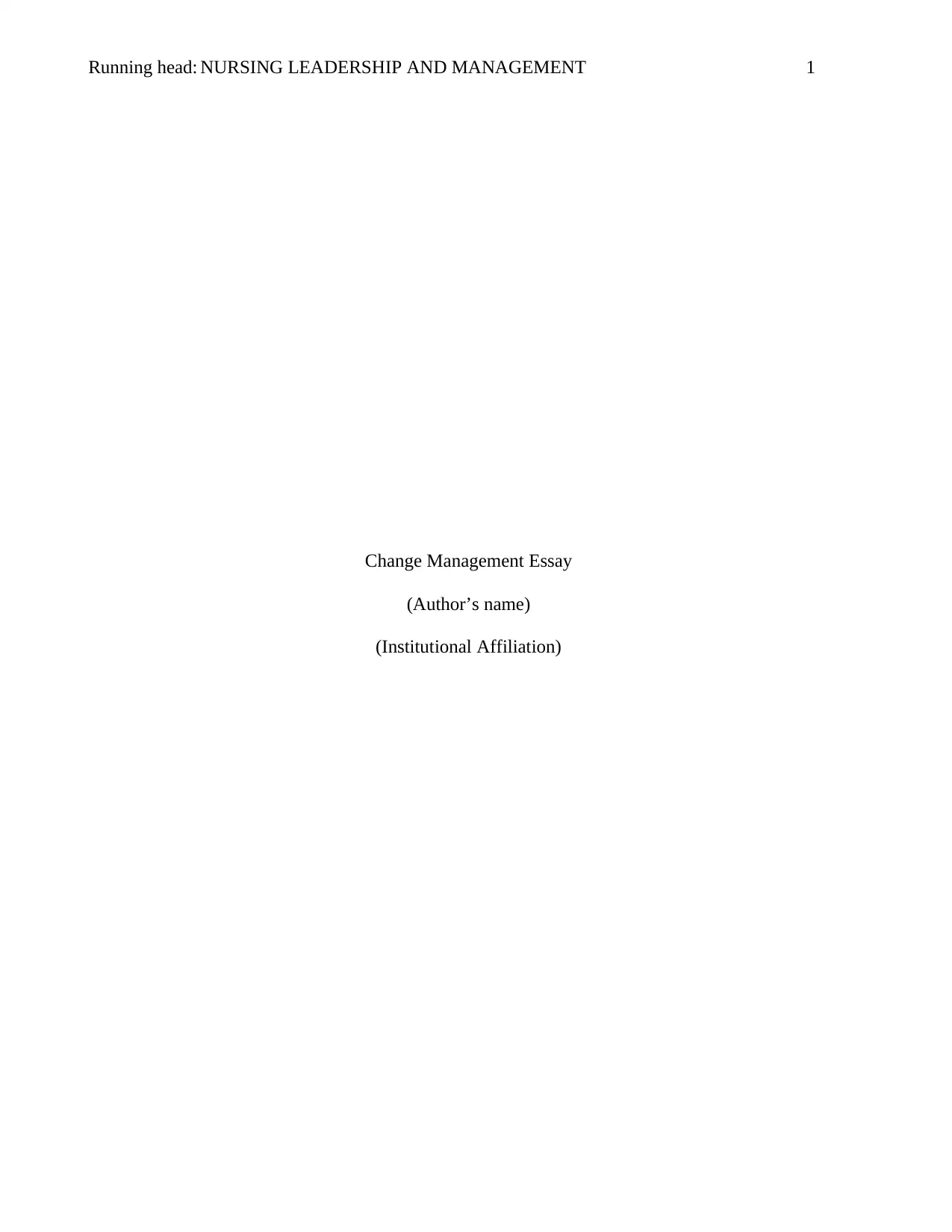
Running head: NURSING LEADERSHIP AND MANAGEMENT 1
Change Management Essay
(Author’s name)
(Institutional Affiliation)
Change Management Essay
(Author’s name)
(Institutional Affiliation)
Paraphrase This Document
Need a fresh take? Get an instant paraphrase of this document with our AI Paraphraser
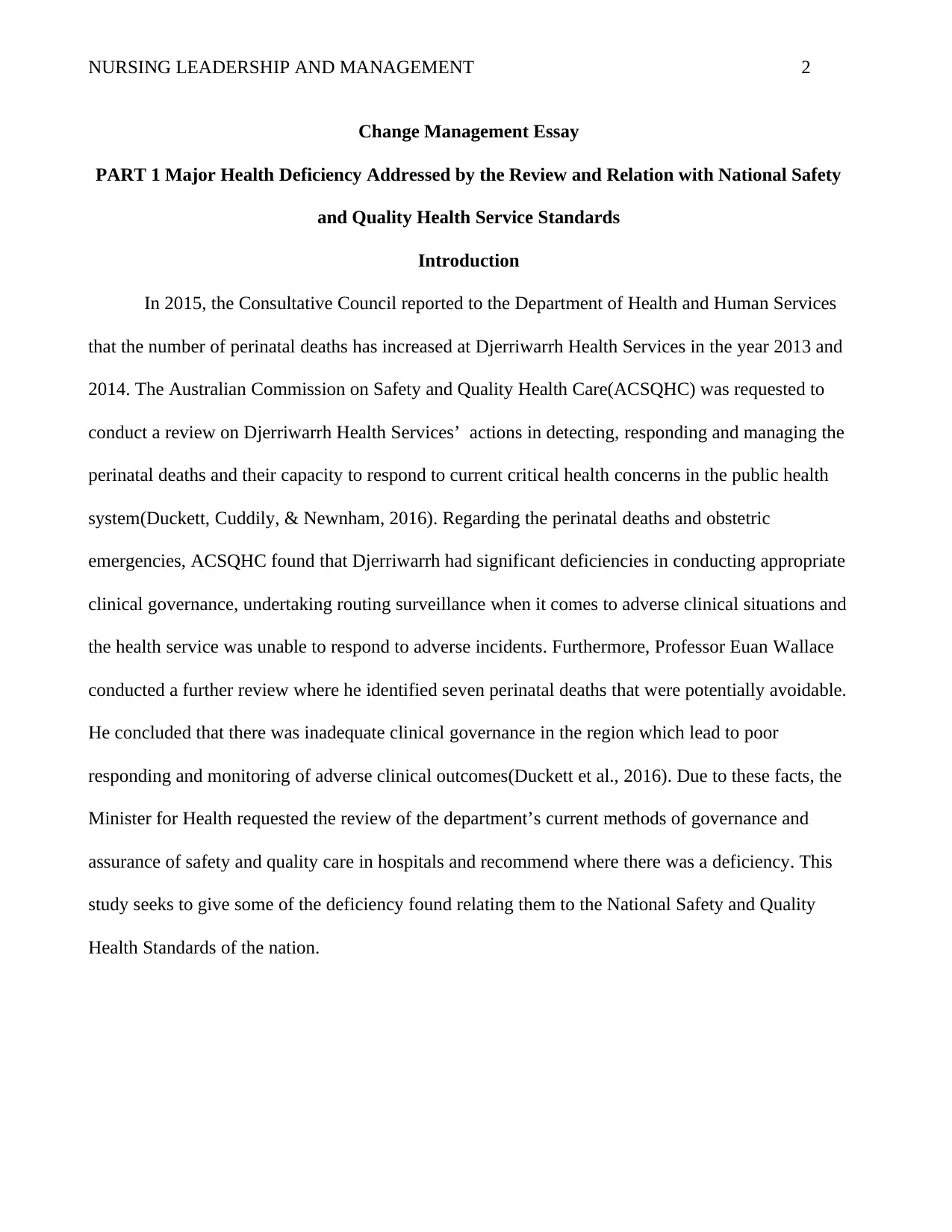
NURSING LEADERSHIP AND MANAGEMENT 2
Change Management Essay
PART 1 Major Health Deficiency Addressed by the Review and Relation with National Safety
and Quality Health Service Standards
Introduction
In 2015, the Consultative Council reported to the Department of Health and Human Services
that the number of perinatal deaths has increased at Djerriwarrh Health Services in the year 2013 and
2014. The Australian Commission on Safety and Quality Health Care(ACSQHC) was requested to
conduct a review on Djerriwarrh Health Services’ actions in detecting, responding and managing the
perinatal deaths and their capacity to respond to current critical health concerns in the public health
system(Duckett, Cuddily, & Newnham, 2016). Regarding the perinatal deaths and obstetric
emergencies, ACSQHC found that Djerriwarrh had significant deficiencies in conducting appropriate
clinical governance, undertaking routing surveillance when it comes to adverse clinical situations and
the health service was unable to respond to adverse incidents. Furthermore, Professor Euan Wallace
conducted a further review where he identified seven perinatal deaths that were potentially avoidable.
He concluded that there was inadequate clinical governance in the region which lead to poor
responding and monitoring of adverse clinical outcomes(Duckett et al., 2016). Due to these facts, the
Minister for Health requested the review of the department’s current methods of governance and
assurance of safety and quality care in hospitals and recommend where there was a deficiency. This
study seeks to give some of the deficiency found relating them to the National Safety and Quality
Health Standards of the nation.
Change Management Essay
PART 1 Major Health Deficiency Addressed by the Review and Relation with National Safety
and Quality Health Service Standards
Introduction
In 2015, the Consultative Council reported to the Department of Health and Human Services
that the number of perinatal deaths has increased at Djerriwarrh Health Services in the year 2013 and
2014. The Australian Commission on Safety and Quality Health Care(ACSQHC) was requested to
conduct a review on Djerriwarrh Health Services’ actions in detecting, responding and managing the
perinatal deaths and their capacity to respond to current critical health concerns in the public health
system(Duckett, Cuddily, & Newnham, 2016). Regarding the perinatal deaths and obstetric
emergencies, ACSQHC found that Djerriwarrh had significant deficiencies in conducting appropriate
clinical governance, undertaking routing surveillance when it comes to adverse clinical situations and
the health service was unable to respond to adverse incidents. Furthermore, Professor Euan Wallace
conducted a further review where he identified seven perinatal deaths that were potentially avoidable.
He concluded that there was inadequate clinical governance in the region which lead to poor
responding and monitoring of adverse clinical outcomes(Duckett et al., 2016). Due to these facts, the
Minister for Health requested the review of the department’s current methods of governance and
assurance of safety and quality care in hospitals and recommend where there was a deficiency. This
study seeks to give some of the deficiency found relating them to the National Safety and Quality
Health Standards of the nation.
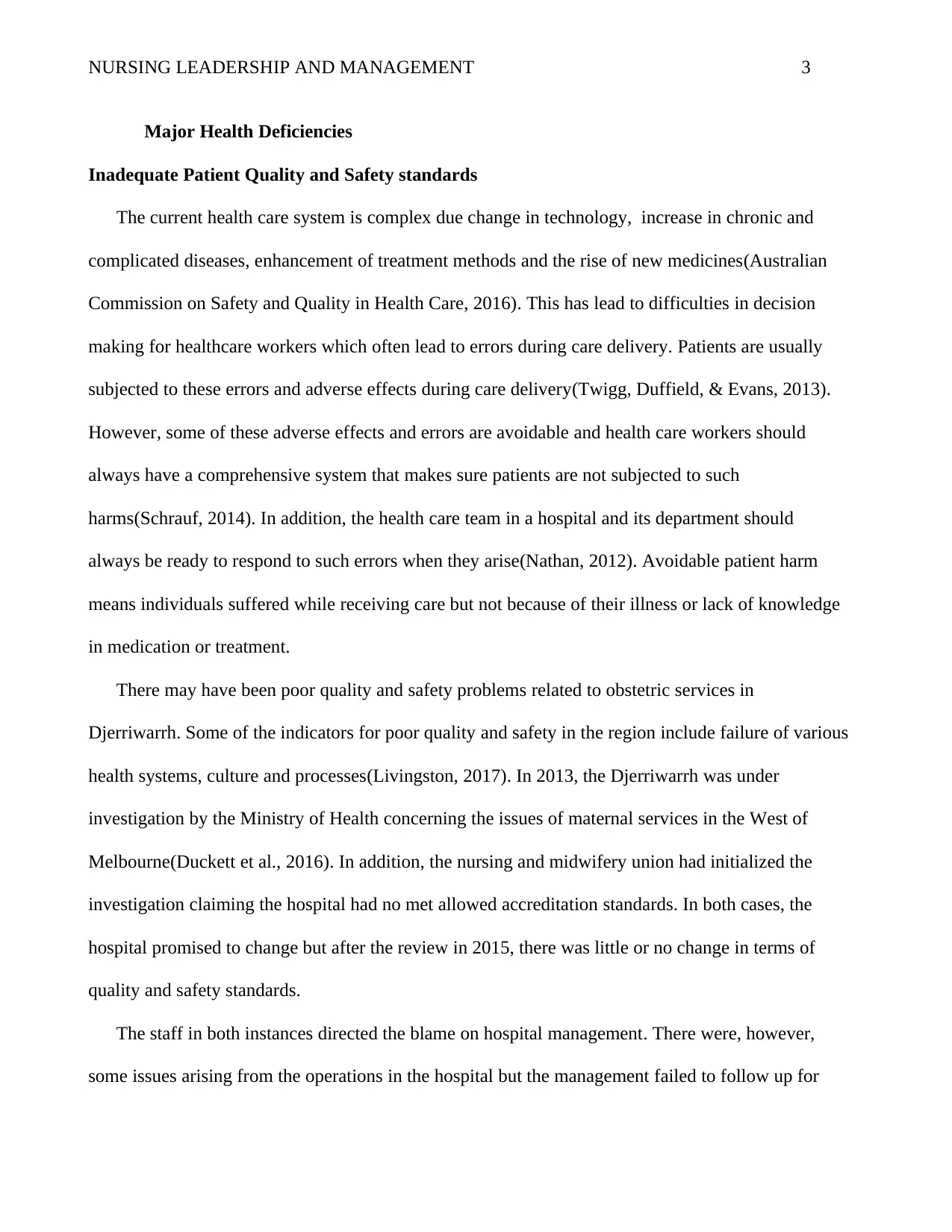
NURSING LEADERSHIP AND MANAGEMENT 3
Major Health Deficiencies
Inadequate Patient Quality and Safety standards
The current health care system is complex due change in technology, increase in chronic and
complicated diseases, enhancement of treatment methods and the rise of new medicines(Australian
Commission on Safety and Quality in Health Care, 2016). This has lead to difficulties in decision
making for healthcare workers which often lead to errors during care delivery. Patients are usually
subjected to these errors and adverse effects during care delivery(Twigg, Duffield, & Evans, 2013).
However, some of these adverse effects and errors are avoidable and health care workers should
always have a comprehensive system that makes sure patients are not subjected to such
harms(Schrauf, 2014). In addition, the health care team in a hospital and its department should
always be ready to respond to such errors when they arise(Nathan, 2012). Avoidable patient harm
means individuals suffered while receiving care but not because of their illness or lack of knowledge
in medication or treatment.
There may have been poor quality and safety problems related to obstetric services in
Djerriwarrh. Some of the indicators for poor quality and safety in the region include failure of various
health systems, culture and processes(Livingston, 2017). In 2013, the Djerriwarrh was under
investigation by the Ministry of Health concerning the issues of maternal services in the West of
Melbourne(Duckett et al., 2016). In addition, the nursing and midwifery union had initialized the
investigation claiming the hospital had no met allowed accreditation standards. In both cases, the
hospital promised to change but after the review in 2015, there was little or no change in terms of
quality and safety standards.
The staff in both instances directed the blame on hospital management. There were, however,
some issues arising from the operations in the hospital but the management failed to follow up for
Major Health Deficiencies
Inadequate Patient Quality and Safety standards
The current health care system is complex due change in technology, increase in chronic and
complicated diseases, enhancement of treatment methods and the rise of new medicines(Australian
Commission on Safety and Quality in Health Care, 2016). This has lead to difficulties in decision
making for healthcare workers which often lead to errors during care delivery. Patients are usually
subjected to these errors and adverse effects during care delivery(Twigg, Duffield, & Evans, 2013).
However, some of these adverse effects and errors are avoidable and health care workers should
always have a comprehensive system that makes sure patients are not subjected to such
harms(Schrauf, 2014). In addition, the health care team in a hospital and its department should
always be ready to respond to such errors when they arise(Nathan, 2012). Avoidable patient harm
means individuals suffered while receiving care but not because of their illness or lack of knowledge
in medication or treatment.
There may have been poor quality and safety problems related to obstetric services in
Djerriwarrh. Some of the indicators for poor quality and safety in the region include failure of various
health systems, culture and processes(Livingston, 2017). In 2013, the Djerriwarrh was under
investigation by the Ministry of Health concerning the issues of maternal services in the West of
Melbourne(Duckett et al., 2016). In addition, the nursing and midwifery union had initialized the
investigation claiming the hospital had no met allowed accreditation standards. In both cases, the
hospital promised to change but after the review in 2015, there was little or no change in terms of
quality and safety standards.
The staff in both instances directed the blame on hospital management. There were, however,
some issues arising from the operations in the hospital but the management failed to follow up for
⊘ This is a preview!⊘
Do you want full access?
Subscribe today to unlock all pages.

Trusted by 1+ million students worldwide
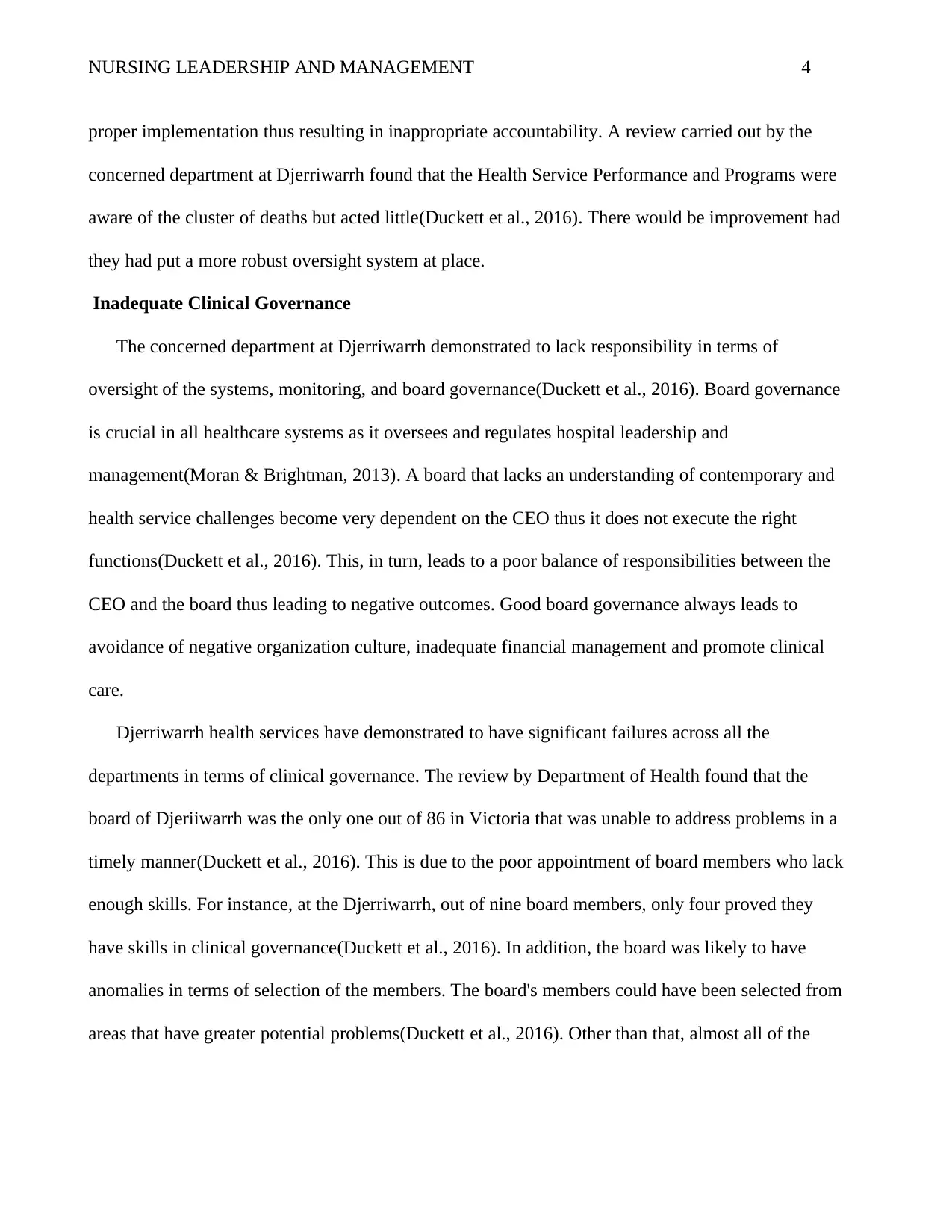
NURSING LEADERSHIP AND MANAGEMENT 4
proper implementation thus resulting in inappropriate accountability. A review carried out by the
concerned department at Djerriwarrh found that the Health Service Performance and Programs were
aware of the cluster of deaths but acted little(Duckett et al., 2016). There would be improvement had
they had put a more robust oversight system at place.
Inadequate Clinical Governance
The concerned department at Djerriwarrh demonstrated to lack responsibility in terms of
oversight of the systems, monitoring, and board governance(Duckett et al., 2016). Board governance
is crucial in all healthcare systems as it oversees and regulates hospital leadership and
management(Moran & Brightman, 2013). A board that lacks an understanding of contemporary and
health service challenges become very dependent on the CEO thus it does not execute the right
functions(Duckett et al., 2016). This, in turn, leads to a poor balance of responsibilities between the
CEO and the board thus leading to negative outcomes. Good board governance always leads to
avoidance of negative organization culture, inadequate financial management and promote clinical
care.
Djerriwarrh health services have demonstrated to have significant failures across all the
departments in terms of clinical governance. The review by Department of Health found that the
board of Djeriiwarrh was the only one out of 86 in Victoria that was unable to address problems in a
timely manner(Duckett et al., 2016). This is due to the poor appointment of board members who lack
enough skills. For instance, at the Djerriwarrh, out of nine board members, only four proved they
have skills in clinical governance(Duckett et al., 2016). In addition, the board was likely to have
anomalies in terms of selection of the members. The board's members could have been selected from
areas that have greater potential problems(Duckett et al., 2016). Other than that, almost all of the
proper implementation thus resulting in inappropriate accountability. A review carried out by the
concerned department at Djerriwarrh found that the Health Service Performance and Programs were
aware of the cluster of deaths but acted little(Duckett et al., 2016). There would be improvement had
they had put a more robust oversight system at place.
Inadequate Clinical Governance
The concerned department at Djerriwarrh demonstrated to lack responsibility in terms of
oversight of the systems, monitoring, and board governance(Duckett et al., 2016). Board governance
is crucial in all healthcare systems as it oversees and regulates hospital leadership and
management(Moran & Brightman, 2013). A board that lacks an understanding of contemporary and
health service challenges become very dependent on the CEO thus it does not execute the right
functions(Duckett et al., 2016). This, in turn, leads to a poor balance of responsibilities between the
CEO and the board thus leading to negative outcomes. Good board governance always leads to
avoidance of negative organization culture, inadequate financial management and promote clinical
care.
Djerriwarrh health services have demonstrated to have significant failures across all the
departments in terms of clinical governance. The review by Department of Health found that the
board of Djeriiwarrh was the only one out of 86 in Victoria that was unable to address problems in a
timely manner(Duckett et al., 2016). This is due to the poor appointment of board members who lack
enough skills. For instance, at the Djerriwarrh, out of nine board members, only four proved they
have skills in clinical governance(Duckett et al., 2016). In addition, the board was likely to have
anomalies in terms of selection of the members. The board's members could have been selected from
areas that have greater potential problems(Duckett et al., 2016). Other than that, almost all of the
Paraphrase This Document
Need a fresh take? Get an instant paraphrase of this document with our AI Paraphraser
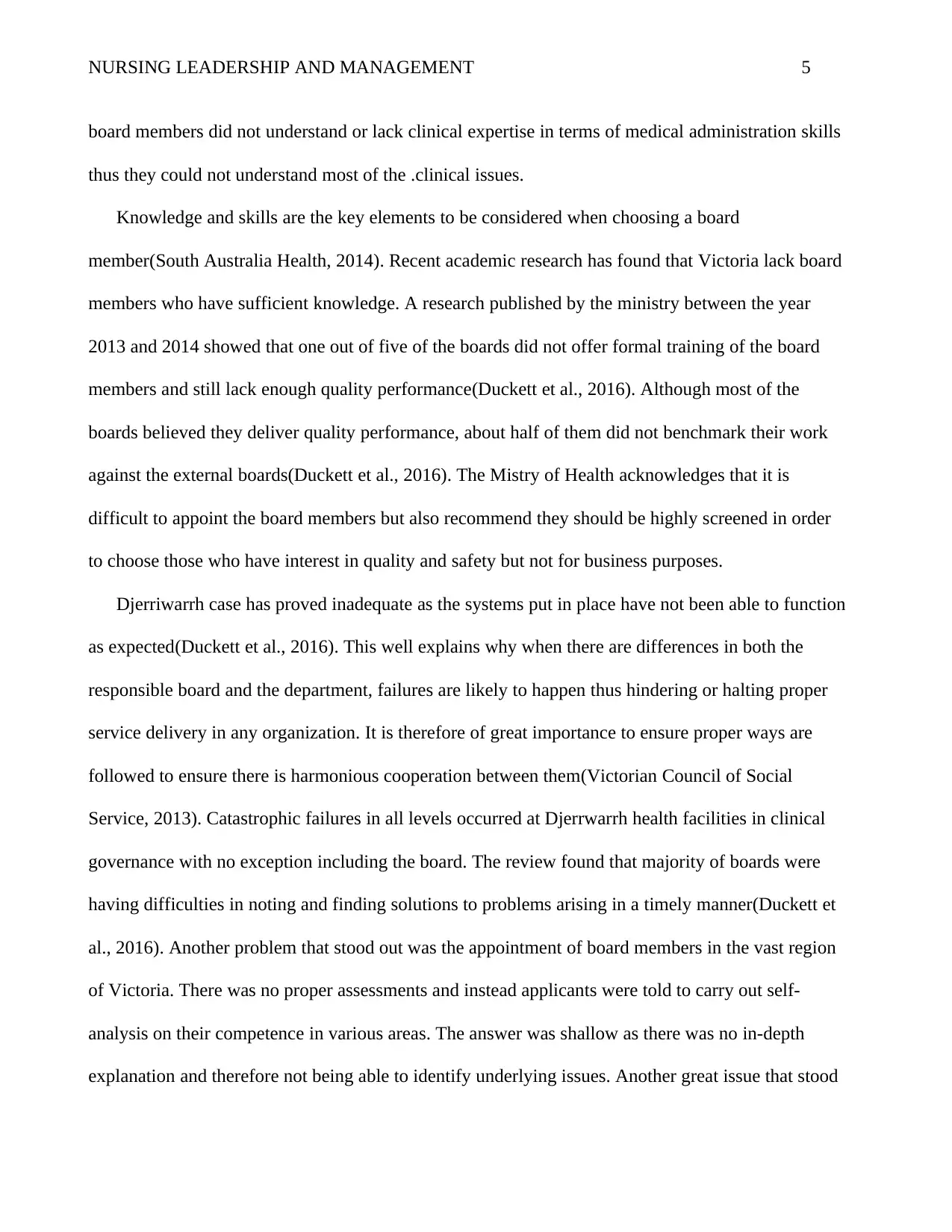
NURSING LEADERSHIP AND MANAGEMENT 5
board members did not understand or lack clinical expertise in terms of medical administration skills
thus they could not understand most of the .clinical issues.
Knowledge and skills are the key elements to be considered when choosing a board
member(South Australia Health, 2014). Recent academic research has found that Victoria lack board
members who have sufficient knowledge. A research published by the ministry between the year
2013 and 2014 showed that one out of five of the boards did not offer formal training of the board
members and still lack enough quality performance(Duckett et al., 2016). Although most of the
boards believed they deliver quality performance, about half of them did not benchmark their work
against the external boards(Duckett et al., 2016). The Mistry of Health acknowledges that it is
difficult to appoint the board members but also recommend they should be highly screened in order
to choose those who have interest in quality and safety but not for business purposes.
Djerriwarrh case has proved inadequate as the systems put in place have not been able to function
as expected(Duckett et al., 2016). This well explains why when there are differences in both the
responsible board and the department, failures are likely to happen thus hindering or halting proper
service delivery in any organization. It is therefore of great importance to ensure proper ways are
followed to ensure there is harmonious cooperation between them(Victorian Council of Social
Service, 2013). Catastrophic failures in all levels occurred at Djerrwarrh health facilities in clinical
governance with no exception including the board. The review found that majority of boards were
having difficulties in noting and finding solutions to problems arising in a timely manner(Duckett et
al., 2016). Another problem that stood out was the appointment of board members in the vast region
of Victoria. There was no proper assessments and instead applicants were told to carry out self-
analysis on their competence in various areas. The answer was shallow as there was no in-depth
explanation and therefore not being able to identify underlying issues. Another great issue that stood
board members did not understand or lack clinical expertise in terms of medical administration skills
thus they could not understand most of the .clinical issues.
Knowledge and skills are the key elements to be considered when choosing a board
member(South Australia Health, 2014). Recent academic research has found that Victoria lack board
members who have sufficient knowledge. A research published by the ministry between the year
2013 and 2014 showed that one out of five of the boards did not offer formal training of the board
members and still lack enough quality performance(Duckett et al., 2016). Although most of the
boards believed they deliver quality performance, about half of them did not benchmark their work
against the external boards(Duckett et al., 2016). The Mistry of Health acknowledges that it is
difficult to appoint the board members but also recommend they should be highly screened in order
to choose those who have interest in quality and safety but not for business purposes.
Djerriwarrh case has proved inadequate as the systems put in place have not been able to function
as expected(Duckett et al., 2016). This well explains why when there are differences in both the
responsible board and the department, failures are likely to happen thus hindering or halting proper
service delivery in any organization. It is therefore of great importance to ensure proper ways are
followed to ensure there is harmonious cooperation between them(Victorian Council of Social
Service, 2013). Catastrophic failures in all levels occurred at Djerrwarrh health facilities in clinical
governance with no exception including the board. The review found that majority of boards were
having difficulties in noting and finding solutions to problems arising in a timely manner(Duckett et
al., 2016). Another problem that stood out was the appointment of board members in the vast region
of Victoria. There was no proper assessments and instead applicants were told to carry out self-
analysis on their competence in various areas. The answer was shallow as there was no in-depth
explanation and therefore not being able to identify underlying issues. Another great issue that stood
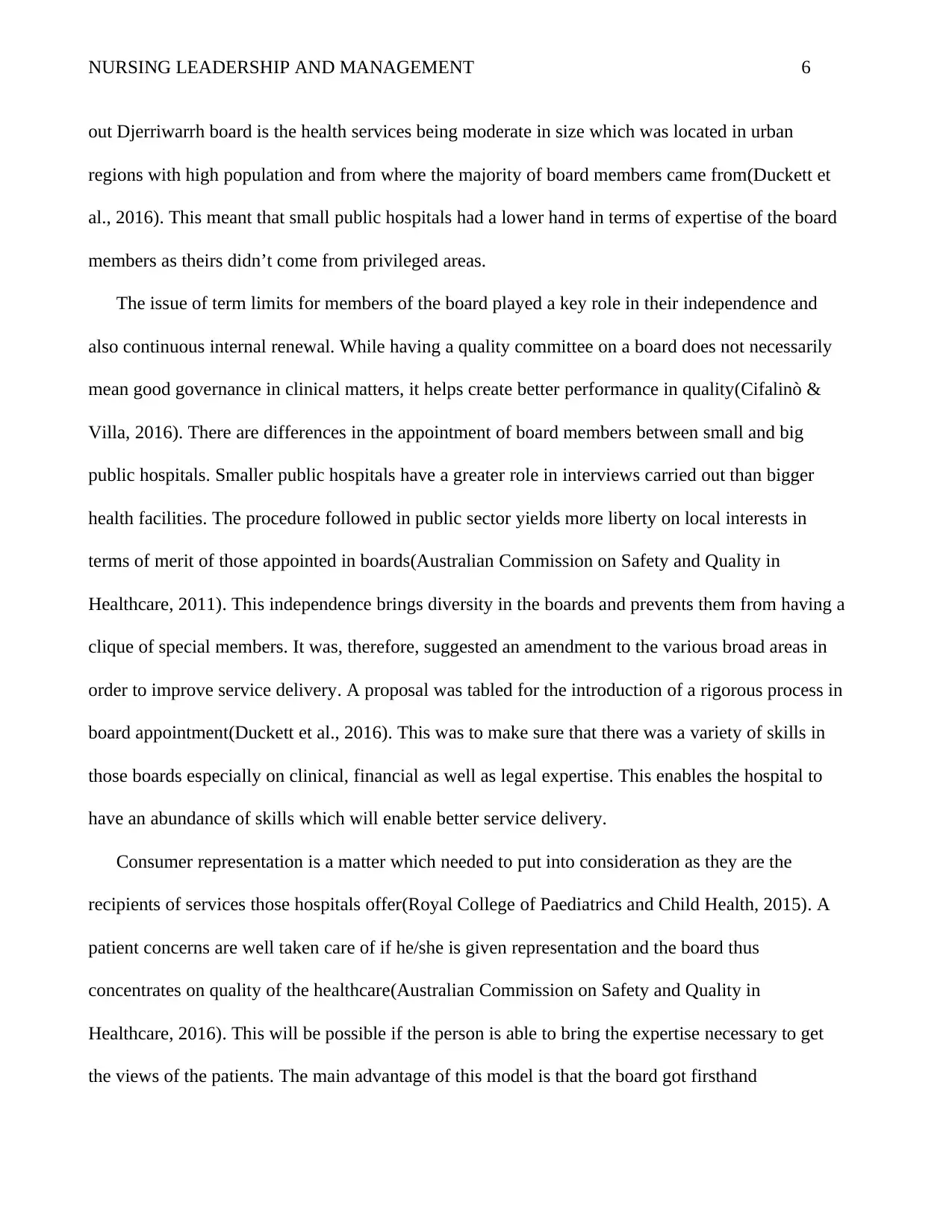
NURSING LEADERSHIP AND MANAGEMENT 6
out Djerriwarrh board is the health services being moderate in size which was located in urban
regions with high population and from where the majority of board members came from(Duckett et
al., 2016). This meant that small public hospitals had a lower hand in terms of expertise of the board
members as theirs didn’t come from privileged areas.
The issue of term limits for members of the board played a key role in their independence and
also continuous internal renewal. While having a quality committee on a board does not necessarily
mean good governance in clinical matters, it helps create better performance in quality(Cifalinò &
Villa, 2016). There are differences in the appointment of board members between small and big
public hospitals. Smaller public hospitals have a greater role in interviews carried out than bigger
health facilities. The procedure followed in public sector yields more liberty on local interests in
terms of merit of those appointed in boards(Australian Commission on Safety and Quality in
Healthcare, 2011). This independence brings diversity in the boards and prevents them from having a
clique of special members. It was, therefore, suggested an amendment to the various broad areas in
order to improve service delivery. A proposal was tabled for the introduction of a rigorous process in
board appointment(Duckett et al., 2016). This was to make sure that there was a variety of skills in
those boards especially on clinical, financial as well as legal expertise. This enables the hospital to
have an abundance of skills which will enable better service delivery.
Consumer representation is a matter which needed to put into consideration as they are the
recipients of services those hospitals offer(Royal College of Paediatrics and Child Health, 2015). A
patient concerns are well taken care of if he/she is given representation and the board thus
concentrates on quality of the healthcare(Australian Commission on Safety and Quality in
Healthcare, 2016). This will be possible if the person is able to bring the expertise necessary to get
the views of the patients. The main advantage of this model is that the board got firsthand
out Djerriwarrh board is the health services being moderate in size which was located in urban
regions with high population and from where the majority of board members came from(Duckett et
al., 2016). This meant that small public hospitals had a lower hand in terms of expertise of the board
members as theirs didn’t come from privileged areas.
The issue of term limits for members of the board played a key role in their independence and
also continuous internal renewal. While having a quality committee on a board does not necessarily
mean good governance in clinical matters, it helps create better performance in quality(Cifalinò &
Villa, 2016). There are differences in the appointment of board members between small and big
public hospitals. Smaller public hospitals have a greater role in interviews carried out than bigger
health facilities. The procedure followed in public sector yields more liberty on local interests in
terms of merit of those appointed in boards(Australian Commission on Safety and Quality in
Healthcare, 2011). This independence brings diversity in the boards and prevents them from having a
clique of special members. It was, therefore, suggested an amendment to the various broad areas in
order to improve service delivery. A proposal was tabled for the introduction of a rigorous process in
board appointment(Duckett et al., 2016). This was to make sure that there was a variety of skills in
those boards especially on clinical, financial as well as legal expertise. This enables the hospital to
have an abundance of skills which will enable better service delivery.
Consumer representation is a matter which needed to put into consideration as they are the
recipients of services those hospitals offer(Royal College of Paediatrics and Child Health, 2015). A
patient concerns are well taken care of if he/she is given representation and the board thus
concentrates on quality of the healthcare(Australian Commission on Safety and Quality in
Healthcare, 2016). This will be possible if the person is able to bring the expertise necessary to get
the views of the patients. The main advantage of this model is that the board got firsthand
⊘ This is a preview!⊘
Do you want full access?
Subscribe today to unlock all pages.

Trusted by 1+ million students worldwide
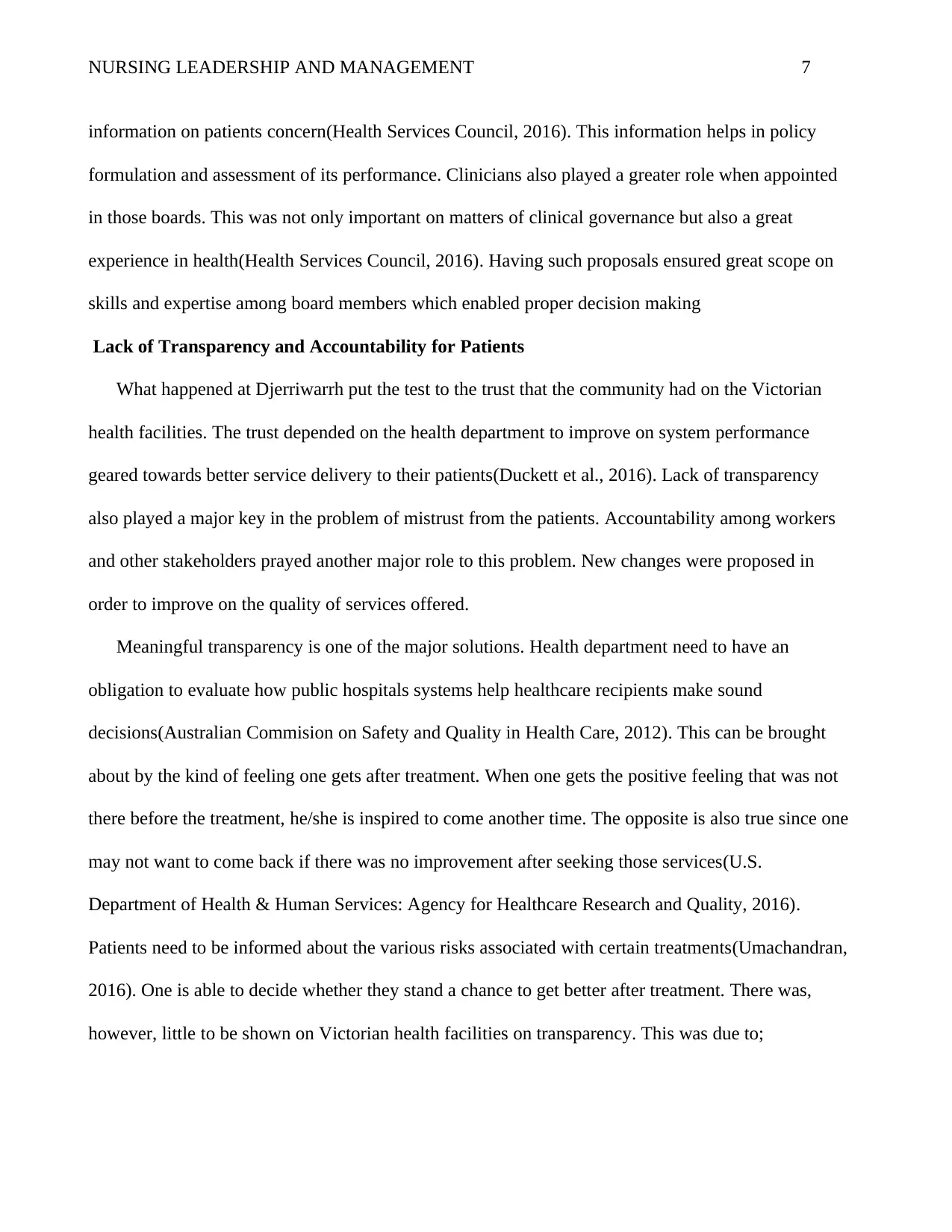
NURSING LEADERSHIP AND MANAGEMENT 7
information on patients concern(Health Services Council, 2016). This information helps in policy
formulation and assessment of its performance. Clinicians also played a greater role when appointed
in those boards. This was not only important on matters of clinical governance but also a great
experience in health(Health Services Council, 2016). Having such proposals ensured great scope on
skills and expertise among board members which enabled proper decision making
Lack of Transparency and Accountability for Patients
What happened at Djerriwarrh put the test to the trust that the community had on the Victorian
health facilities. The trust depended on the health department to improve on system performance
geared towards better service delivery to their patients(Duckett et al., 2016). Lack of transparency
also played a major key in the problem of mistrust from the patients. Accountability among workers
and other stakeholders prayed another major role to this problem. New changes were proposed in
order to improve on the quality of services offered.
Meaningful transparency is one of the major solutions. Health department need to have an
obligation to evaluate how public hospitals systems help healthcare recipients make sound
decisions(Australian Commision on Safety and Quality in Health Care, 2012). This can be brought
about by the kind of feeling one gets after treatment. When one gets the positive feeling that was not
there before the treatment, he/she is inspired to come another time. The opposite is also true since one
may not want to come back if there was no improvement after seeking those services(U.S.
Department of Health & Human Services: Agency for Healthcare Research and Quality, 2016).
Patients need to be informed about the various risks associated with certain treatments(Umachandran,
2016). One is able to decide whether they stand a chance to get better after treatment. There was,
however, little to be shown on Victorian health facilities on transparency. This was due to;
information on patients concern(Health Services Council, 2016). This information helps in policy
formulation and assessment of its performance. Clinicians also played a greater role when appointed
in those boards. This was not only important on matters of clinical governance but also a great
experience in health(Health Services Council, 2016). Having such proposals ensured great scope on
skills and expertise among board members which enabled proper decision making
Lack of Transparency and Accountability for Patients
What happened at Djerriwarrh put the test to the trust that the community had on the Victorian
health facilities. The trust depended on the health department to improve on system performance
geared towards better service delivery to their patients(Duckett et al., 2016). Lack of transparency
also played a major key in the problem of mistrust from the patients. Accountability among workers
and other stakeholders prayed another major role to this problem. New changes were proposed in
order to improve on the quality of services offered.
Meaningful transparency is one of the major solutions. Health department need to have an
obligation to evaluate how public hospitals systems help healthcare recipients make sound
decisions(Australian Commision on Safety and Quality in Health Care, 2012). This can be brought
about by the kind of feeling one gets after treatment. When one gets the positive feeling that was not
there before the treatment, he/she is inspired to come another time. The opposite is also true since one
may not want to come back if there was no improvement after seeking those services(U.S.
Department of Health & Human Services: Agency for Healthcare Research and Quality, 2016).
Patients need to be informed about the various risks associated with certain treatments(Umachandran,
2016). One is able to decide whether they stand a chance to get better after treatment. There was,
however, little to be shown on Victorian health facilities on transparency. This was due to;
Paraphrase This Document
Need a fresh take? Get an instant paraphrase of this document with our AI Paraphraser
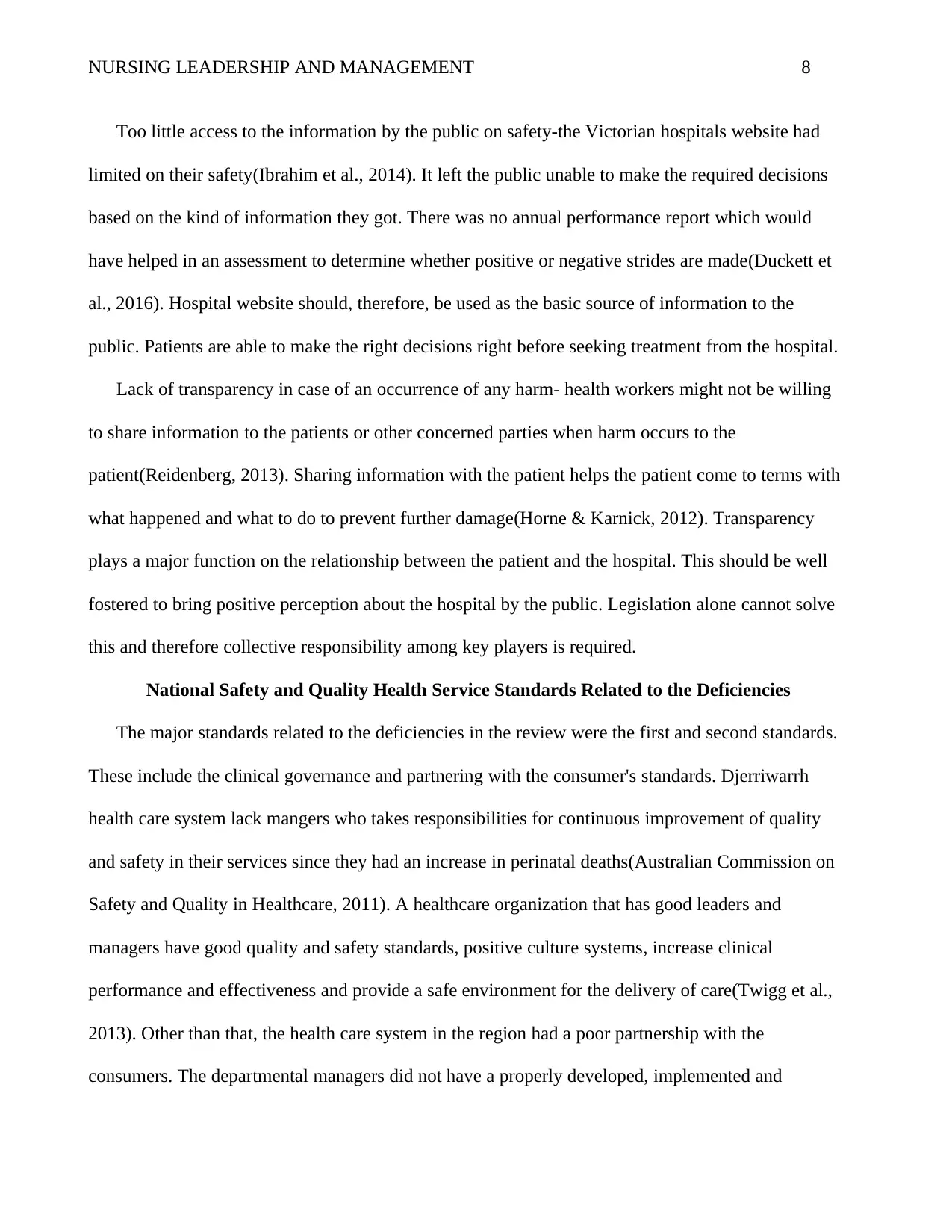
NURSING LEADERSHIP AND MANAGEMENT 8
Too little access to the information by the public on safety-the Victorian hospitals website had
limited on their safety(Ibrahim et al., 2014). It left the public unable to make the required decisions
based on the kind of information they got. There was no annual performance report which would
have helped in an assessment to determine whether positive or negative strides are made(Duckett et
al., 2016). Hospital website should, therefore, be used as the basic source of information to the
public. Patients are able to make the right decisions right before seeking treatment from the hospital.
Lack of transparency in case of an occurrence of any harm- health workers might not be willing
to share information to the patients or other concerned parties when harm occurs to the
patient(Reidenberg, 2013). Sharing information with the patient helps the patient come to terms with
what happened and what to do to prevent further damage(Horne & Karnick, 2012). Transparency
plays a major function on the relationship between the patient and the hospital. This should be well
fostered to bring positive perception about the hospital by the public. Legislation alone cannot solve
this and therefore collective responsibility among key players is required.
National Safety and Quality Health Service Standards Related to the Deficiencies
The major standards related to the deficiencies in the review were the first and second standards.
These include the clinical governance and partnering with the consumer's standards. Djerriwarrh
health care system lack mangers who takes responsibilities for continuous improvement of quality
and safety in their services since they had an increase in perinatal deaths(Australian Commission on
Safety and Quality in Healthcare, 2011). A healthcare organization that has good leaders and
managers have good quality and safety standards, positive culture systems, increase clinical
performance and effectiveness and provide a safe environment for the delivery of care(Twigg et al.,
2013). Other than that, the health care system in the region had a poor partnership with the
consumers. The departmental managers did not have a properly developed, implemented and
Too little access to the information by the public on safety-the Victorian hospitals website had
limited on their safety(Ibrahim et al., 2014). It left the public unable to make the required decisions
based on the kind of information they got. There was no annual performance report which would
have helped in an assessment to determine whether positive or negative strides are made(Duckett et
al., 2016). Hospital website should, therefore, be used as the basic source of information to the
public. Patients are able to make the right decisions right before seeking treatment from the hospital.
Lack of transparency in case of an occurrence of any harm- health workers might not be willing
to share information to the patients or other concerned parties when harm occurs to the
patient(Reidenberg, 2013). Sharing information with the patient helps the patient come to terms with
what happened and what to do to prevent further damage(Horne & Karnick, 2012). Transparency
plays a major function on the relationship between the patient and the hospital. This should be well
fostered to bring positive perception about the hospital by the public. Legislation alone cannot solve
this and therefore collective responsibility among key players is required.
National Safety and Quality Health Service Standards Related to the Deficiencies
The major standards related to the deficiencies in the review were the first and second standards.
These include the clinical governance and partnering with the consumer's standards. Djerriwarrh
health care system lack mangers who takes responsibilities for continuous improvement of quality
and safety in their services since they had an increase in perinatal deaths(Australian Commission on
Safety and Quality in Healthcare, 2011). A healthcare organization that has good leaders and
managers have good quality and safety standards, positive culture systems, increase clinical
performance and effectiveness and provide a safe environment for the delivery of care(Twigg et al.,
2013). Other than that, the health care system in the region had a poor partnership with the
consumers. The departmental managers did not have a properly developed, implemented and
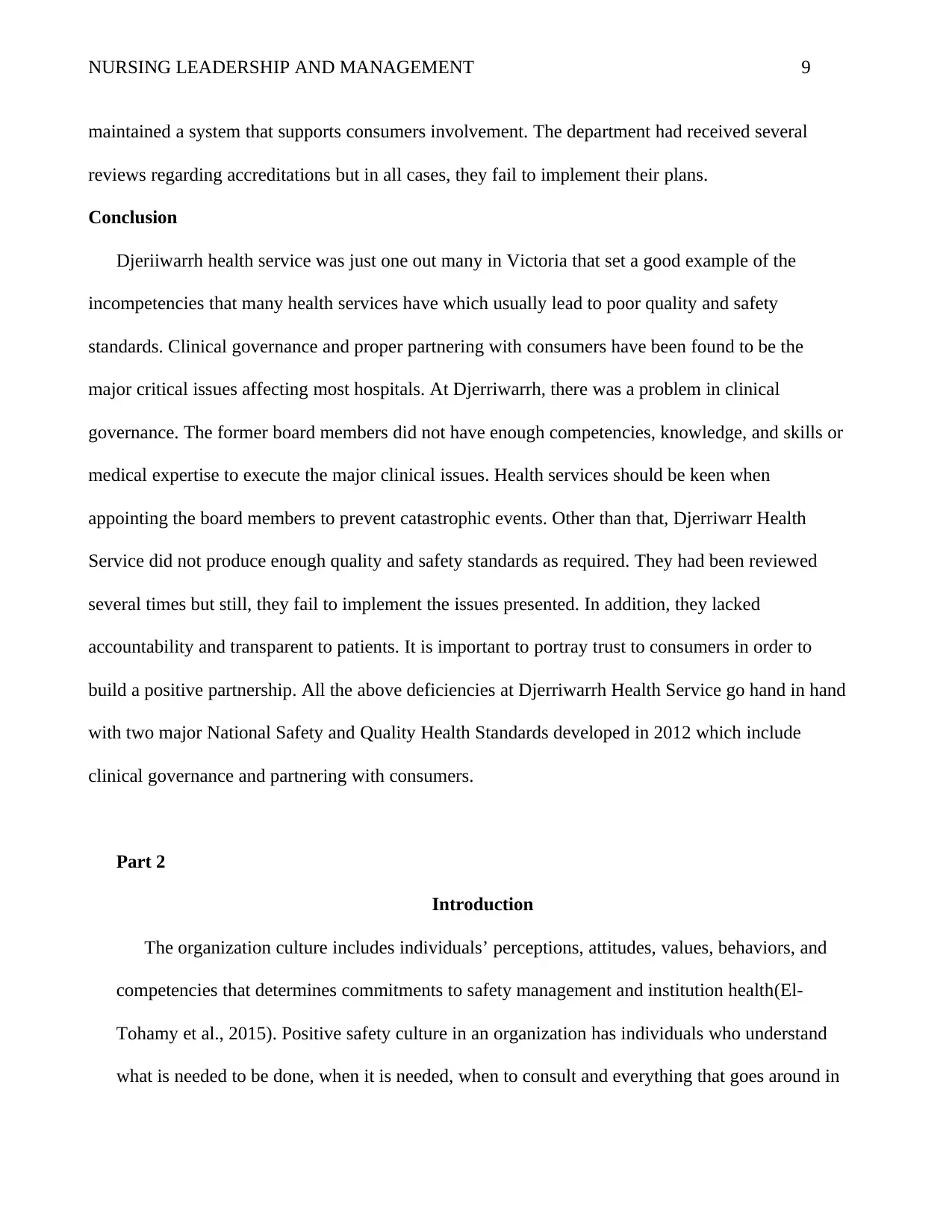
NURSING LEADERSHIP AND MANAGEMENT 9
maintained a system that supports consumers involvement. The department had received several
reviews regarding accreditations but in all cases, they fail to implement their plans.
Conclusion
Djeriiwarrh health service was just one out many in Victoria that set a good example of the
incompetencies that many health services have which usually lead to poor quality and safety
standards. Clinical governance and proper partnering with consumers have been found to be the
major critical issues affecting most hospitals. At Djerriwarrh, there was a problem in clinical
governance. The former board members did not have enough competencies, knowledge, and skills or
medical expertise to execute the major clinical issues. Health services should be keen when
appointing the board members to prevent catastrophic events. Other than that, Djerriwarr Health
Service did not produce enough quality and safety standards as required. They had been reviewed
several times but still, they fail to implement the issues presented. In addition, they lacked
accountability and transparent to patients. It is important to portray trust to consumers in order to
build a positive partnership. All the above deficiencies at Djerriwarrh Health Service go hand in hand
with two major National Safety and Quality Health Standards developed in 2012 which include
clinical governance and partnering with consumers.
Part 2
Introduction
The organization culture includes individuals’ perceptions, attitudes, values, behaviors, and
competencies that determines commitments to safety management and institution health(El-
Tohamy et al., 2015). Positive safety culture in an organization has individuals who understand
what is needed to be done, when it is needed, when to consult and everything that goes around in
maintained a system that supports consumers involvement. The department had received several
reviews regarding accreditations but in all cases, they fail to implement their plans.
Conclusion
Djeriiwarrh health service was just one out many in Victoria that set a good example of the
incompetencies that many health services have which usually lead to poor quality and safety
standards. Clinical governance and proper partnering with consumers have been found to be the
major critical issues affecting most hospitals. At Djerriwarrh, there was a problem in clinical
governance. The former board members did not have enough competencies, knowledge, and skills or
medical expertise to execute the major clinical issues. Health services should be keen when
appointing the board members to prevent catastrophic events. Other than that, Djerriwarr Health
Service did not produce enough quality and safety standards as required. They had been reviewed
several times but still, they fail to implement the issues presented. In addition, they lacked
accountability and transparent to patients. It is important to portray trust to consumers in order to
build a positive partnership. All the above deficiencies at Djerriwarrh Health Service go hand in hand
with two major National Safety and Quality Health Standards developed in 2012 which include
clinical governance and partnering with consumers.
Part 2
Introduction
The organization culture includes individuals’ perceptions, attitudes, values, behaviors, and
competencies that determines commitments to safety management and institution health(El-
Tohamy et al., 2015). Positive safety culture in an organization has individuals who understand
what is needed to be done, when it is needed, when to consult and everything that goes around in
⊘ This is a preview!⊘
Do you want full access?
Subscribe today to unlock all pages.

Trusted by 1+ million students worldwide
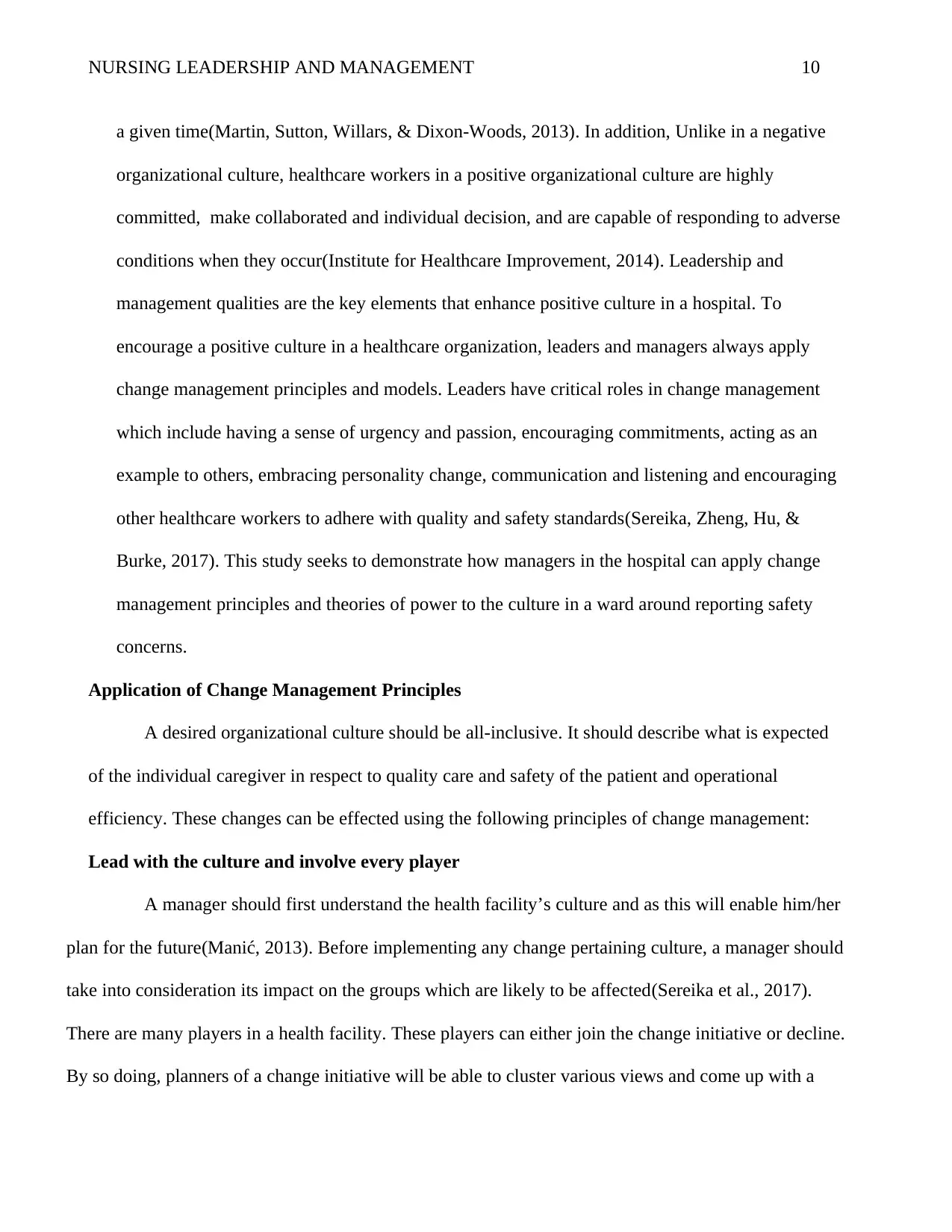
NURSING LEADERSHIP AND MANAGEMENT 10
a given time(Martin, Sutton, Willars, & Dixon-Woods, 2013). In addition, Unlike in a negative
organizational culture, healthcare workers in a positive organizational culture are highly
committed, make collaborated and individual decision, and are capable of responding to adverse
conditions when they occur(Institute for Healthcare Improvement, 2014). Leadership and
management qualities are the key elements that enhance positive culture in a hospital. To
encourage a positive culture in a healthcare organization, leaders and managers always apply
change management principles and models. Leaders have critical roles in change management
which include having a sense of urgency and passion, encouraging commitments, acting as an
example to others, embracing personality change, communication and listening and encouraging
other healthcare workers to adhere with quality and safety standards(Sereika, Zheng, Hu, &
Burke, 2017). This study seeks to demonstrate how managers in the hospital can apply change
management principles and theories of power to the culture in a ward around reporting safety
concerns.
Application of Change Management Principles
A desired organizational culture should be all-inclusive. It should describe what is expected
of the individual caregiver in respect to quality care and safety of the patient and operational
efficiency. These changes can be effected using the following principles of change management:
Lead with the culture and involve every player
A manager should first understand the health facility’s culture and as this will enable him/her
plan for the future(Manić, 2013). Before implementing any change pertaining culture, a manager should
take into consideration its impact on the groups which are likely to be affected(Sereika et al., 2017).
There are many players in a health facility. These players can either join the change initiative or decline.
By so doing, planners of a change initiative will be able to cluster various views and come up with a
a given time(Martin, Sutton, Willars, & Dixon-Woods, 2013). In addition, Unlike in a negative
organizational culture, healthcare workers in a positive organizational culture are highly
committed, make collaborated and individual decision, and are capable of responding to adverse
conditions when they occur(Institute for Healthcare Improvement, 2014). Leadership and
management qualities are the key elements that enhance positive culture in a hospital. To
encourage a positive culture in a healthcare organization, leaders and managers always apply
change management principles and models. Leaders have critical roles in change management
which include having a sense of urgency and passion, encouraging commitments, acting as an
example to others, embracing personality change, communication and listening and encouraging
other healthcare workers to adhere with quality and safety standards(Sereika, Zheng, Hu, &
Burke, 2017). This study seeks to demonstrate how managers in the hospital can apply change
management principles and theories of power to the culture in a ward around reporting safety
concerns.
Application of Change Management Principles
A desired organizational culture should be all-inclusive. It should describe what is expected
of the individual caregiver in respect to quality care and safety of the patient and operational
efficiency. These changes can be effected using the following principles of change management:
Lead with the culture and involve every player
A manager should first understand the health facility’s culture and as this will enable him/her
plan for the future(Manić, 2013). Before implementing any change pertaining culture, a manager should
take into consideration its impact on the groups which are likely to be affected(Sereika et al., 2017).
There are many players in a health facility. These players can either join the change initiative or decline.
By so doing, planners of a change initiative will be able to cluster various views and come up with a
Paraphrase This Document
Need a fresh take? Get an instant paraphrase of this document with our AI Paraphraser
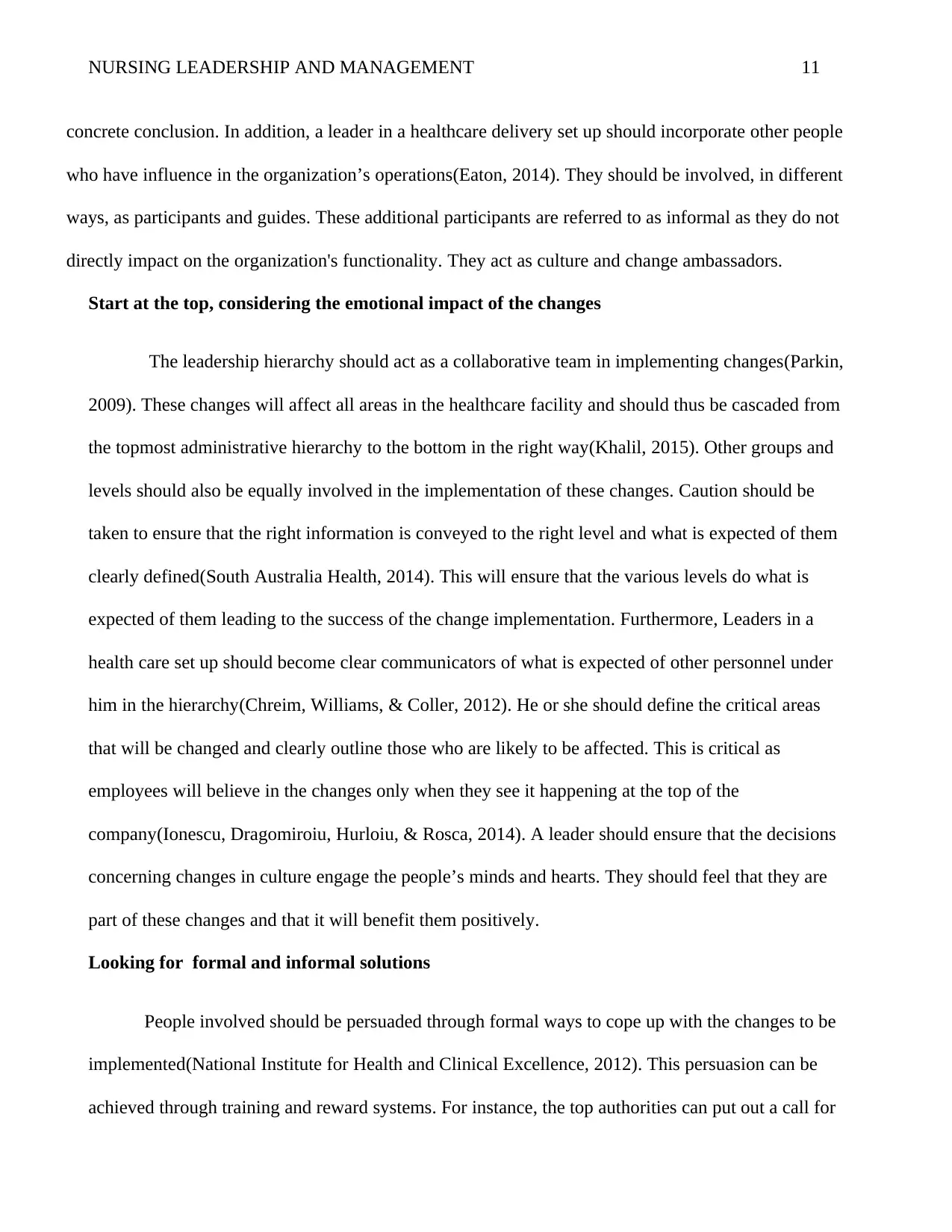
NURSING LEADERSHIP AND MANAGEMENT 11
concrete conclusion. In addition, a leader in a healthcare delivery set up should incorporate other people
who have influence in the organization’s operations(Eaton, 2014). They should be involved, in different
ways, as participants and guides. These additional participants are referred to as informal as they do not
directly impact on the organization's functionality. They act as culture and change ambassadors.
Start at the top, considering the emotional impact of the changes
The leadership hierarchy should act as a collaborative team in implementing changes(Parkin,
2009). These changes will affect all areas in the healthcare facility and should thus be cascaded from
the topmost administrative hierarchy to the bottom in the right way(Khalil, 2015). Other groups and
levels should also be equally involved in the implementation of these changes. Caution should be
taken to ensure that the right information is conveyed to the right level and what is expected of them
clearly defined(South Australia Health, 2014). This will ensure that the various levels do what is
expected of them leading to the success of the change implementation. Furthermore, Leaders in a
health care set up should become clear communicators of what is expected of other personnel under
him in the hierarchy(Chreim, Williams, & Coller, 2012). He or she should define the critical areas
that will be changed and clearly outline those who are likely to be affected. This is critical as
employees will believe in the changes only when they see it happening at the top of the
company(Ionescu, Dragomiroiu, Hurloiu, & Rosca, 2014). A leader should ensure that the decisions
concerning changes in culture engage the people’s minds and hearts. They should feel that they are
part of these changes and that it will benefit them positively.
Looking for formal and informal solutions
People involved should be persuaded through formal ways to cope up with the changes to be
implemented(National Institute for Health and Clinical Excellence, 2012). This persuasion can be
achieved through training and reward systems. For instance, the top authorities can put out a call for
concrete conclusion. In addition, a leader in a healthcare delivery set up should incorporate other people
who have influence in the organization’s operations(Eaton, 2014). They should be involved, in different
ways, as participants and guides. These additional participants are referred to as informal as they do not
directly impact on the organization's functionality. They act as culture and change ambassadors.
Start at the top, considering the emotional impact of the changes
The leadership hierarchy should act as a collaborative team in implementing changes(Parkin,
2009). These changes will affect all areas in the healthcare facility and should thus be cascaded from
the topmost administrative hierarchy to the bottom in the right way(Khalil, 2015). Other groups and
levels should also be equally involved in the implementation of these changes. Caution should be
taken to ensure that the right information is conveyed to the right level and what is expected of them
clearly defined(South Australia Health, 2014). This will ensure that the various levels do what is
expected of them leading to the success of the change implementation. Furthermore, Leaders in a
health care set up should become clear communicators of what is expected of other personnel under
him in the hierarchy(Chreim, Williams, & Coller, 2012). He or she should define the critical areas
that will be changed and clearly outline those who are likely to be affected. This is critical as
employees will believe in the changes only when they see it happening at the top of the
company(Ionescu, Dragomiroiu, Hurloiu, & Rosca, 2014). A leader should ensure that the decisions
concerning changes in culture engage the people’s minds and hearts. They should feel that they are
part of these changes and that it will benefit them positively.
Looking for formal and informal solutions
People involved should be persuaded through formal ways to cope up with the changes to be
implemented(National Institute for Health and Clinical Excellence, 2012). This persuasion can be
achieved through training and reward systems. For instance, the top authorities can put out a call for
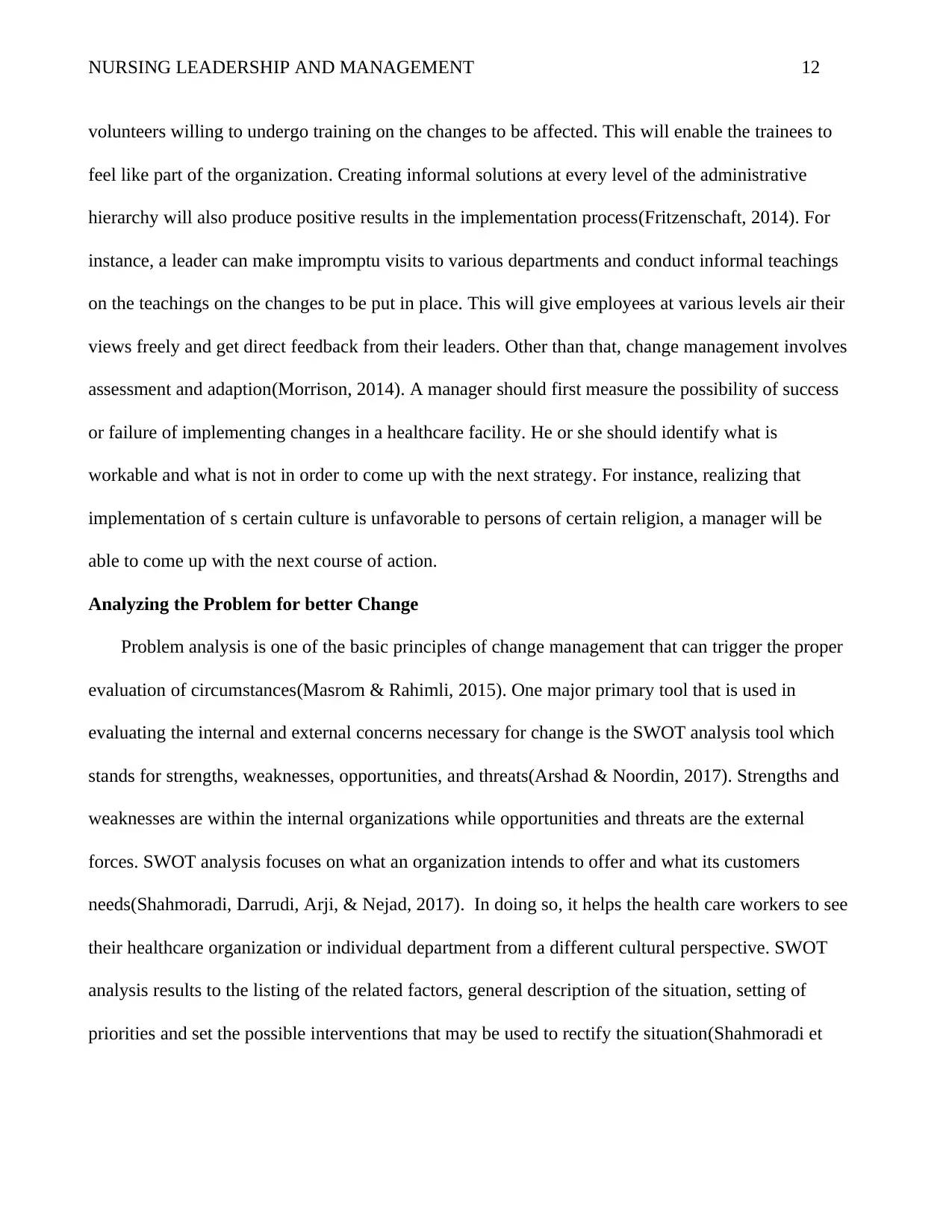
NURSING LEADERSHIP AND MANAGEMENT 12
volunteers willing to undergo training on the changes to be affected. This will enable the trainees to
feel like part of the organization. Creating informal solutions at every level of the administrative
hierarchy will also produce positive results in the implementation process(Fritzenschaft, 2014). For
instance, a leader can make impromptu visits to various departments and conduct informal teachings
on the teachings on the changes to be put in place. This will give employees at various levels air their
views freely and get direct feedback from their leaders. Other than that, change management involves
assessment and adaption(Morrison, 2014). A manager should first measure the possibility of success
or failure of implementing changes in a healthcare facility. He or she should identify what is
workable and what is not in order to come up with the next strategy. For instance, realizing that
implementation of s certain culture is unfavorable to persons of certain religion, a manager will be
able to come up with the next course of action.
Analyzing the Problem for better Change
Problem analysis is one of the basic principles of change management that can trigger the proper
evaluation of circumstances(Masrom & Rahimli, 2015). One major primary tool that is used in
evaluating the internal and external concerns necessary for change is the SWOT analysis tool which
stands for strengths, weaknesses, opportunities, and threats(Arshad & Noordin, 2017). Strengths and
weaknesses are within the internal organizations while opportunities and threats are the external
forces. SWOT analysis focuses on what an organization intends to offer and what its customers
needs(Shahmoradi, Darrudi, Arji, & Nejad, 2017). In doing so, it helps the health care workers to see
their healthcare organization or individual department from a different cultural perspective. SWOT
analysis results to the listing of the related factors, general description of the situation, setting of
priorities and set the possible interventions that may be used to rectify the situation(Shahmoradi et
volunteers willing to undergo training on the changes to be affected. This will enable the trainees to
feel like part of the organization. Creating informal solutions at every level of the administrative
hierarchy will also produce positive results in the implementation process(Fritzenschaft, 2014). For
instance, a leader can make impromptu visits to various departments and conduct informal teachings
on the teachings on the changes to be put in place. This will give employees at various levels air their
views freely and get direct feedback from their leaders. Other than that, change management involves
assessment and adaption(Morrison, 2014). A manager should first measure the possibility of success
or failure of implementing changes in a healthcare facility. He or she should identify what is
workable and what is not in order to come up with the next strategy. For instance, realizing that
implementation of s certain culture is unfavorable to persons of certain religion, a manager will be
able to come up with the next course of action.
Analyzing the Problem for better Change
Problem analysis is one of the basic principles of change management that can trigger the proper
evaluation of circumstances(Masrom & Rahimli, 2015). One major primary tool that is used in
evaluating the internal and external concerns necessary for change is the SWOT analysis tool which
stands for strengths, weaknesses, opportunities, and threats(Arshad & Noordin, 2017). Strengths and
weaknesses are within the internal organizations while opportunities and threats are the external
forces. SWOT analysis focuses on what an organization intends to offer and what its customers
needs(Shahmoradi, Darrudi, Arji, & Nejad, 2017). In doing so, it helps the health care workers to see
their healthcare organization or individual department from a different cultural perspective. SWOT
analysis results to the listing of the related factors, general description of the situation, setting of
priorities and set the possible interventions that may be used to rectify the situation(Shahmoradi et
⊘ This is a preview!⊘
Do you want full access?
Subscribe today to unlock all pages.

Trusted by 1+ million students worldwide
1 out of 24
Related Documents
Your All-in-One AI-Powered Toolkit for Academic Success.
+13062052269
info@desklib.com
Available 24*7 on WhatsApp / Email
![[object Object]](/_next/static/media/star-bottom.7253800d.svg)
Unlock your academic potential
Copyright © 2020–2025 A2Z Services. All Rights Reserved. Developed and managed by ZUCOL.





